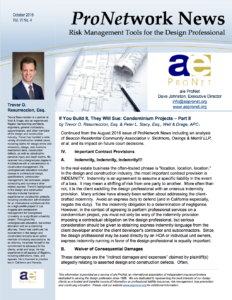 Do architects owe a “duty of care” to the homeowners of a condominium project with whom the architects have no contractual privity? According to the California Supreme Court, they do. What does this mean in practical terms? The answer is that architects are now more than ever exposed to potential future claims and lawsuits brought by homeowners and the homeowners’ associations years after the project has been completed even where the architect’s design decisions are trumped by those of the project developer, and the architect’s role in the construction phase of the project is limited.
Do architects owe a “duty of care” to the homeowners of a condominium project with whom the architects have no contractual privity? According to the California Supreme Court, they do. What does this mean in practical terms? The answer is that architects are now more than ever exposed to potential future claims and lawsuits brought by homeowners and the homeowners’ associations years after the project has been completed even where the architect’s design decisions are trumped by those of the project developer, and the architect’s role in the construction phase of the project is limited.
The purpose of this paper is to provide background on an architect’s potential liability to its client and third parties on condominium projects as well as guidance on how to prospectively address the concerns highlighted by a recent California Supreme Court decision and many other lawsuits in which architects have been sued by third parties. Specifically, we address the following topics: assessing your owner client, important contract provisions, and insurance issues. The intent is to provide a roadmap for architects in assessing their risks on condominium projects and a practical approach to addressing those risks. While it may not be possible to fully insulate architects from all risks, it is certainly a good practice to have a firm understanding of those risks and to address the risks up front. Benjamin Franklin is attributed with the statement: “In this world nothing can be said to be certain, except death and taxes.” For architects who design condominium projects, unfortunately, lawsuits should be added to that list.
II. The Beacon Case – A Bellwether for Future Court Decisions?
In July 2014, the California Supreme Court declared that an architect owes a duty of care to future homeowners where the architect is a “principal architect” on the project. (Beacon Residential Community Association v. Skidmore, Owings & Merrill LLP, et al., 59 Cal.4th 568, 327 P.3d 850 (2014) (“Beacon”).) 2 The Court held that this duty applies “even if the architect does not actually build the project or exercise ultimate control over construction decisions.” (Id. at 581, 327 P.3d 850, 859.) Shocking? Yes! The more significant question is whether YOU are prepared to provide design services on a condominium project in light of the California Supreme Court’s recent decision. The Beacon case is particularly apropos to this paper because it involved a condominium project.
This is an excerpt of the August 2016 issue of ProNetwork News. Download the full PDF of If You Build It, They Will Sue: Condominium Projects – Part I to continue reading. Along with further explanation of the relevance of The Beacon Case, the first in this two-part series includes a section on Assessing Your Owner Client. Next month, we’ll post Part II to The ProNet Blog. As always, these newsletters are available to all a/e ProNet clients the month they are published. If you’d like to take advantage of this value-added service, get in touch with your local a/e ProNet broker today.
About the Author
Trevor Resurreccion is a partner at Weil & Drage, and an experienced litigator representing architects, engineers, general contractors, subcontractors, and other members of the design and construction industry. Trevor has handled a wide variety of construction related cases, including claims for design errors and omissions, delays, cost overruns, mechanic’s liens, construction defects, as well as catastrophic personal injury and death claims. He received his undergraduate degree in Architecture with a concentration in construction management. Trevor’s background in the design and construction industry includes hands-on experience on construction projects, including construction administration for an international architectural firm on a high-profile project in Los Angeles and construction management for Georgetown University on a significant university project. As an attorney, he prides himself in his commitment to advocacy for his clients, small and large. He has experience in all aspects of litigation, including arbitrations, trials, and appeals. He is licensed to practice law in California and Nevada.




